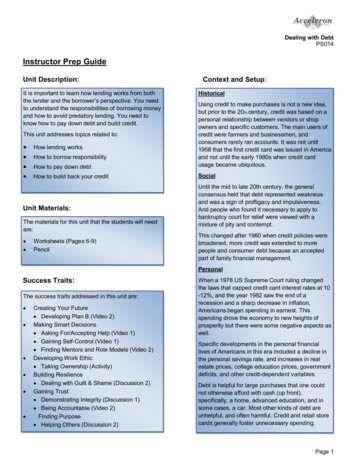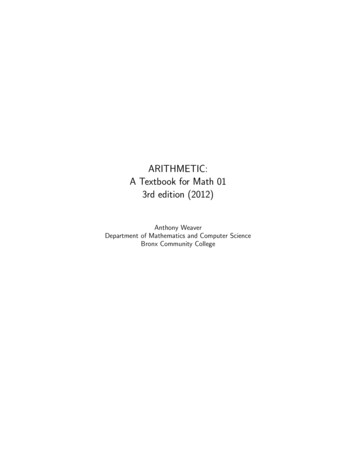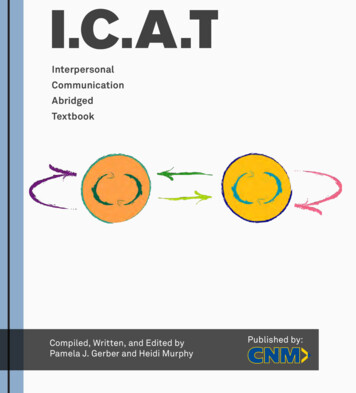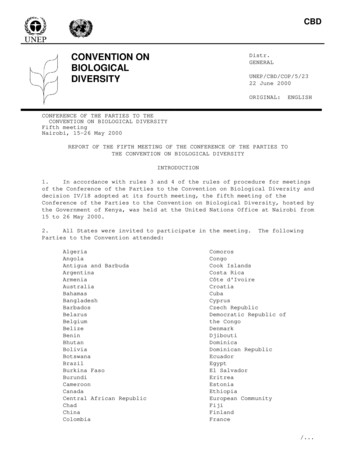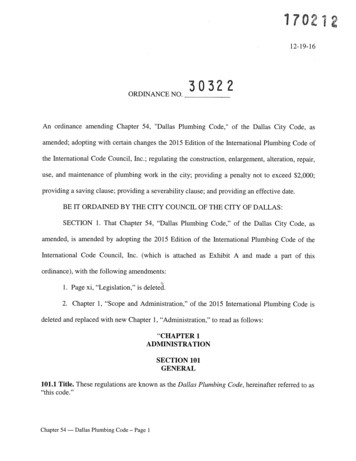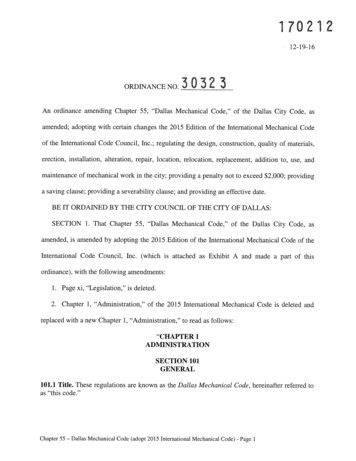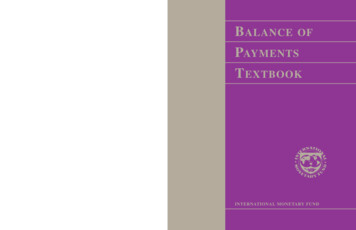
Transcription
B ALANCE OFPAYMENTST EXTBOOKINTERNATIONAL MONETARY FUND
BALANCE OFPAYMENTSTEXTBOOKINTERNATIONAL MONETARY FUND
1996 International Monetary FundCataloging-in-Publication DataBalance of payments textbook. — Washington, DC, USA :International Monetary Fund, 1996.viii, 150 p.Companion volume to: Balance of payments manual. 5th ed.and Balance of payments compilation guide.ISBN 1-55775-570-11. Balance of payments — Statistics.I. International Monetary Fund.HG3882.B342 1996Price: US 25.00Please send orders to:International Monetary Fund, Publication Services700 19th Street, NW, Washington, DC 20431, USATelephone (202) 623-7430Telefax (202) 623-7201Internet: publications@imf.org
ContentsForewordI.viiThe Balance of Payments Conceptual Framework1Definition of the Balance of Payments 1Double Entry System 2Concept of an Economy 4Principles for Valuation and Time of Recording; Unit of Account and Procedures for Conversion 4Coverage of the Balance of Payments 7II.Residents of an Economy12Definition of Residents 13Households and Individuals 13Enterprises 15Nonprofit Institutions 22Government 23III.Classifying Balance of Payments Transactions26Structural Overview of the Standard Components 26Goods, Services, and Income 27Current Transfers 28Capital Account 28Financial Account 29International Investment Position 29Standard Components of the Balance of Payments 30Selected Supplementary Information 34Standard Components of the International Investment Position 36IV.Goods39Convention for Recording Change of Ownership 40Exceptions to the Change of Ownership Rule 41Physical Movement of Goods and the Goods Component 44Time of Recording 47Valuation 48Adjustments to Basic Data 53V.Services60Transportation Services 60Travel 67Other Services 69iii
CONTENTSVI.Income77Definition 77Compensation of Employees 77Investment Income 79VII.Current Transfers and the Capital Account88General Information on Transfers 88Current Transfers 89Capital Transfers 92Transactions in Non-Produced, Nonfinancial Assets 94VIII.Introduction to the Financial Account95Definition and Coverage 95Transactions in Financial Assets 96Financial Item Changes to Be Excluded from the Balance of Payments 99Net Recording 100Valuation and Timing 100Classification 100Supplementary Classifications 103IX.Direct Investment107The Concept of Direct Investment 107Motivation for Direct Investment 107Defining the Direct Investment Relationship 107Direct Investment Capital 109Direction of Investment 110Valuation 112Special Cases 113X.Portfolio Investment117Equity 117Bonds and Notes 117Money Market Instruments 118Financial Derivatives 120XI.Other Investment124Trade Credits 124Use of Fund Credit and Loans from the Fund 125Other Loans 125Currency and Deposits 126Other Assets and Liabilities 127XII.Reserve Assets129Reserve Assets and the Adjustment Process 129The Relationship Between Reserve Assets and Liabilities 131Coverage of Reserve Assets 134Transactions with the International Monetary Fund 138iv
CONTENTSXIII.The International Investment Position140Balance Sheets and the International Investment Position 140The Relationship between the International Investment Position and the Balance of Payments 141Calculation of Price and Exchange Rate Changes 144Classifying the International Investment Position 145Valuation of the International Investment Position 146A Practical Example of International Investment Position Compilation 148v
ForewordThe Balance of Payments Textbook (the Textbook)is the second of two companion documents to thefifth edition of the Balance of Payments Manual (theManual), which was published by the InternationalMonetary Fund in 1993. The fifth edition of theManual addresses the many important changes thathave occurred in international transactions,harmonizes (as closely as possible) balance ofpayments concepts with the revised System ofNational Accounts 1993 and other IMF statisticalmethodologies, and covers the important topic ofinternational investment position statistics. TheBalance of Payments Compilation Guide, publishedby the IMF in 1995, offers practical direction forusing established and emerging data sources andapplying or adapting a variety of methods tocompile statistics for the balance of payments andthe international investment position. Publication ofthe Balance of Payments Textbook completes thetrilogy that provides a comprehensive range ofinformation on the compilation of balance ofpayments statistics and will, it is hoped, make asignificant contribution to the understanding ofbalance of payments issues.The Textbook is intended as one of the mainreference materials for training courses in balance ofpayments methodology. Such courses may beconducted—under the aegis of the IMF Institute—bythe Statistics Department at IMF headquarters inWashington, DC or organized externally. TheTextbook is designed to provide illustrative examplesand applications of concepts, definitions,classifications, and conventions contained in theManual and to afford compilers with opportunitiesfor enhancing their understanding of the relevantparts of the Manual.The Textbook was produced by the IMF StatisticsDepartment under the supervision of Mr. MahinderS. Gill, assistant director, Balance of Payments andExternal Debt Division I (BOPED I). The task ofdrafting and finalizing the Textbook was undertakenby Mr. Peter Harper, an economist in BOPED I.Ms. Nancy W. Basham edited and coordinated printproduction of the Textbook, and Ms. SuzannaPersaud, administrative staff assistant in BOPED I,typed the final version.I am hopeful that the Textbook, as part of thecomprehensive range of documentation on balanceof payments methodology now available, will makea significant contribution to the training of compilersas well as users of balance of payments statistics.John B. McLenaghanDirector, Statistics DepartmentInternational Monetary Fundvii
I.The Balance of Payments Conceptual Framework1. Balance of payments statistics are included in abroad set of economic statistics known as thenational accounts. The System of National Accounts1993 (1993 SNA) presents the conceptual frameworkfor the national accounts, and the fifth edition (1993)of the Balance of Payments Manual (the BPM)presents the conceptual framework and the structureand classification of the balance of payments. Thehigh level of concordance between the 1993 SNAand the BPM is extremely important.1 This firstchapter of the Balance of Payments Textbook (theTextbook) presents the balance of paymentsconceptual framework and certain internationallyagreed-upon accounting conventions that haveinfluenced the shape of that framework. Theseconcepts and specific aspects of methodology areelaborated in subsequent Textbook chapters.Definition of the Balance of Payments2. As defined in the BPM, the balance ofpayments (BOP) is a statistical statement thatsystematically summarizes, for a specific time period,the economic transactions of an economy with therest of the world. Transactions, for the most partbetween residents and nonresidents, consist of thoseinvolving goods, services, and income; those involvingfinancial claims on, and liabilities to, the rest of theworld; and those (such as gifts) classified as transfers,which involve offsetting entries to balance—in anaccounting sense—one-sided transactions. Eachcomponent of this important definition issubsequently examined.3. The balance of payments is concerned withtransactions and thus deals with flows rather thanwith stocks. That is, the balance of payments dealswith economic events that take place during areference period and not with outstanding totals ofeconomic assets and liabilities that exist at particularmoments in time.1The relationship between BOP statistics and national accounts statistics isdescribed in detail in chapter 3 of the BPM.4. The initial focus of the Textbook is on transactions(between an economy and the rest of the world) ingoods, services, and income. Under whatcircumstances does an international economicoccurrence constitute a transaction in the BOP senseof the word? In the framework of the nationalaccounts, transactions in goods, services, or incomeare the provision, by one party to another, of realresources of this kind. Thus defined, a transactioninvolves two parties or transactors. It is not alwaysclear, however, that there are two parties. Realresources are often transferred internationally fromone constituent unit to another within the same legalentity. (For example, real resources may betransferred between a branch and the head office ofa multinational enterprise.) It is equally difficult todetermine whether transactions take place whenindividuals migrate and transfer assets from theirformer to their new countries. How should realresources that accompany migrating individuals beregarded? Such movements of resources do notinvolve two parties although, in the process, thewealth of some economies is diminished (countriesof emigration) and the wealth of other economies isincreased (countries of immigration). Whenindividuals migrate, the economic impact of theshifts in real resources is similar to that of flows ofresources between two parties. It is thereforepossible to regard these shifts as transactions in arestricted sense. The determination of whatconstitutes a transaction must not be made strictly onthe basis of logic but through adoption of generallyagreed-upon conventions. For the sake ofconvenience, the term transaction is often usedbroadly in the BPM to refer to any sort of flow orchange that is, by convention, shown in the balanceof payments.5. The BPM definition (see paragraph 2 on thispage) of the balance of payments also includestransactions in an economy’s external financialassets and liabilities. These transactions arise from(a) the creation or extinction of an external financialasset or liability or (b) from a change in theownership of an existing external financial asset and1
THE BALANCE OF PAYMENTS CONCEPTUAL FRAMEWORKliability. Transactions that involve external financialassets and two resident parties and transactions thatinvolve external financial liabilities and twononresident parties are, theoretically, included in thebalance of payments.2 Often, these transactions aretransparent in the BOP presentation. However, someBOP presentations explicitly reflect thesetransactions if (for transactions in external financialassets) the two residents are in different sectors ofthe economy or if (for transactions involvingexternal financial liabilities) the two nonresidentsare residents of different countries.6. An issue of frequent debate is whether BOPcoverage should be restricted to transactions orwhether, at the other extreme, the BOP statementshould show all changes in the value of aneconomy’s holdings of external financial items.Opinions have differed, and conventions reflectingdifferent analytic approaches have been suggested.The conventions recommended in the fifth edition ofthe BPM generally require a narrow view of BOPcoverage.7. This narrow view of BOP coverage should beconsidered in relation to the closely connected,stock-oriented international investment position. Theinternational investment position (IIP) is astatistical statement (compiled as of a specific datesuch as year end) of the value and composition ofan economy’s claims on the rest of the world and thevalue of that economy’s financial liabilities to therest of the world. The difference between aneconomy’s stock of international financial assets andfinancial liabilities is that part of an economy’s networth attributable to, or derived from, its externalsector.8. Those who are more interested in changes in aneconomy’s holdings of external financial items thanin transactions in these items can obtain thenecessary information by calculating the differencebetween IIP statements compiled for differentperiods. In addition to changes in BOP transactions,the difference will reflect valuation changes (suchas those associated with movements in exchangerates or in prices of financial items) and otheradjustments (such as uncompensated seizures anddebt write-offs).2Such transactions are included for pragmatic reasons and to increase theanalytical usefulness of the statistics. For additional discussion on this topic,see paragraphs 454–455 of chapter 8 of the Textbook.2Double Entry System9. The balance of payments is a statistical statementstructured in systematic fashion; data in thestatement are presented according to specificaccounting rules. The basic accounting conventionfor a BOP statement is that every recordedtransaction is represented by two entries with exactlyequal values. In a BOP statement, the two entriesare used to recognize the giving and receiving sidesof every transaction. Therefore, the BOP statement isanalogous to a typical financial statement preparedin accordance with the double entry system regularlyused for business accounting.10. The dual entry system underlying BOPaccounting is governed by certain rules. Thus, inconformity with business and national accounting, inthe balance of payments, the term credit is used todenote a reduction in assets or an increase inliabilities, and the term debit is used to denote areduction in liabilities or an increase in assets. Thisusage has been supplemented by the rule that everyrecording of a debit movement shall be matched bythe recording of a credit movement and vice versa.For example, Dromesia borrows 200,000 units inCromanian currency from the government ofCromania and deposits the money with a Cromaniancommercial bank. Dromesia then acquires an asset(the bank balance) as well as incurring a liability(the debt to the government of Cromania). The assetaccount is debited, and the liability account iscredited. The Dromesian BOP entries to record thetransaction are:CreditLiabilities (obligation to Cromania)Assets (bank balance in Cromania)Debit200,000200,00011. In the preceding (and in succeeding) statements,credits are entered on the left-hand side, and debitsare entered on the right-hand side. This traditionalpractice in BOP accounting differs from commercialaccounting procedure in some countries.12. Changes in assets are, of course, associated withmany other types of change besides changes inliabilities. An increase in one asset may be associatedwith a decrease in another. For example, Mr. Jonesin Cromania purchases goods from Mrs. Smith inDromesia but does not pay for them. Mrs. Smith’sclaim against Mr. Jones is a trade credit and an assetof Dromesia. When Mr. Jones pays this debt inCromanian currency, Dromesia’s trade credit assetsare decreased and its foreign currency assets are
CHAPTER Iincreased. According to the rule stated in paragraph10, the increase in one asset (foreign currency) isrecorded as a debit, and the decrease in the otherasset (trade credit) is recorded as a credit. As always,the debit is offset by an equal credit. If the goodspurchased by Mr. Jones are worth 1,000 units, thetwo entries in Dromesia’s balance of paymentswould be:Assets (trade credit)Assets (foreign currency)Credit1,000Debit1,00013. An increase in one liability may be associatedwith a decrease in another. If the example inparagraph 12 is viewed from Cromania’s perspective,the trade credit owed to Mrs. Smith is a liability.When Mr. Jones pays for the goods in Cromaniancurrency, the trade credit liability ceases to exist. Inits place, the Cromanian banking system incurs aliability (in the form of a deposit in Cromaniancurrency) to a resident of Dromesia. The increase inthe bank’s liability is recorded as a credit, and thedecrease in Cromanian trade credit liability is shownas a debit. The balance of payments entries are:Liability (bank deposit)Liability (trade credit)Credit1,000Debit1,00014. On the basis of rules stating that an increase inassets is recorded as a debit, that an increase inliabilities is recorded as a credit, and that everycredit entry is matched by a corresponding debitentry, accounting conventions can be formulated forcredits and debits in the balance of payments. Underthe conventions of the system, the compilingeconomy records credit entries for (a) exports ofgoods, provision of services, provision of the factorsof production to another economy and (b) financialitems reflecting a reduction in the economy’sexternal assets or an increase in external liabilities.Conversely, the compiling economy records debitentries for (a) imports of goods, acquisition ofservices, use of production factors provided byanother economy and (b) financial items reflectingan increase in assets or a decrease in liabilities. Inother words, for real or financial assets, a positivefigure (credit) indicates a decrease in holdings, and anegative figure (debit) indicates an increase. Forliabilities in the form of financial instruments, therule is reversed; a positive figure indicates anincrease and a negative one, a decrease.15. Most entries in the balance of payments pertainto transactions in which economic values areprovided or acquired in exchange for othereconomic values. Offsetting credit and debit entriesrequired by the recording system are often theautomatic result of two entries of equal amountbeing made for two items that have beenexchanged. For example, a commodity import isrecorded in the statistics for goods, and payment forthat import is recorded in the banking statistics forchanges in assets or liabilities. When items aredonated or when recordings are one-sided for otherreasons, only one aspect of the transaction isrecorded automatically in source data. Special typesof entries called transfers are made in the balance ofpayments to provide the required offsets. Transfersare shown as credits when the entries for which thetransfers provide offsets are debits and as debitswhen those entries are credits.16. In summary form, double entry accountingconventions used in the balance of payments consistof:Credit (CR) entriesExports of goods and servicesIncome receivableOffsets to real or financial resources received without aquid pro quo (transfers)Increases in liabilitiesDecreases in financial assetsDebit (DR) entriesImports of goods and servicesIncome payableOffsets to real or financial resources provided without aquid pro quo (transfers)Increases in financial assetsDecreases in liabilities17. Techniques of BOP analysis are largely based onthe double entry recording system of BOPstatements. BOP analysis identifies and groupstransactions that are autonomous (undertaken fortheir own sake) and all other transactions that canbe characterized as flows induced to financeautonomous transactions. When entries aredivided—on the basis of these or any othercharacteristics—into two groups, the sums of the twogroups will (in theory) be numerically equal andhave opposite signs.3 The principal focus of BOPanalysis is on the selection of characteristics to beisolated and the subsequent examination ofrelationships between the resultant partial balancesthat can be constructed.3The achievement of such equality is unlikely in practice because of errorsand omissions.3
THE BALANCE OF PAYMENTS CONCEPTUAL FRAMEWORKConcept of an Economy18. In general, the balance of payments is a recordof economic flows occurring between residents ofone economy and residents of the rest of the world.An economy is defined as an economic entity havinga center of economic interest within a specificterritory. Economy is thus nearly synonymous withcountry as the balance of payments (in practice)usually deals with transactions between nations. Intheory, an economy can represent a small portion ofa large national territory. An economy may alsoconsist of more than one country—for example, theEconomic Union of Belgium and Luxembourg. Inaddition, it is possible to consider the balance ofpayments of such regional groups as the EuropeanUnion (EU) and the balance of payments of eachgroup member. (See chapter 4 of the BPM andchapter 2 of this Textbook for the definition ofresident economic entities and guidelines fordistinguishing them from nonresident economicentities.)Principles for Valuation and Time ofRecording; Unit of Account andProcedures for Conversion19. As BOP transactions are diverse, the BPMprovides clear guidance on how to value transactionsand in which periods the transactions should berecorded. In addition, because transactions may bedenominated in many currencies, BOP statisticiansshould be sure to select the most appropriate unit ofaccount in which to express the statement and thebest procedures for converting flows from transactioncurrencies into the unit of account.Valuation20. The application of a uniform principle ofvaluation to all transactions recorded in the balanceof payments is necessary for three reasons. First, aseach transaction has two aspects, the double entryaccounting rule would be violated if credit and debitentries did not possess the same values. Second, theabsence of a uniform valuation principle wouldmake it impossible to compare the BOP statement ofone country with the BOP statements of othercountries because the valuation of entries made bypartner countries would lack symmetry. Third, werea uniform valuation system not used, items recordedin the balance of payments could not be comparedwith one another, and serious problems ofinterpretation would be created for data users.4Questions concerning the valuation of transactionsare not limited to BOP statistics; similar problemsarise for compilers of national accounts. For bothBOP and national accounting systems, the solutionhas been to adopt a uniform basis for pricing.21. The assignment of value to an economictransaction on the basis of price is by no meansstraightforward. A range of prices may exist for anyasset. For example, for commodities, there may bequoted prices or list prices at both wholesale andretail levels. The same commodity may be priceddifferently in geographically separated markets.Customs authorities of various countries maycompile price lists for use in assessing duties to bepaid. The balance sheets of enterprises may carryreal assets valued in terms of production costs (if theenterprises produced the articles), in terms ofacquisition or historical costs, in terms of depreciatedreplacement costs, or in terms of market values. Intransactions conducted between affiliated enterprises,transfer pricing may be utilized. In general, however,transactions between such enterprises will be valuedat the purchase or sales prices that would berealized in commercial exchanges made under “arm’slength” conditions.22. Market prices are widely used in the generalfield of economics as a means to measure thedeployment of resources. The use of market pricesfor valuing transactions is therefore recommended inthe BPM and is consistent with the 1993 SNA.Admittedly, there may be some practical problems inimplementing this recommendation. Adjustmentsmay be required for the reported values of a largenumber of individual transactions, and it may bedifficult to determine suitable market price proxiesfor transactions that have not actually taken place ina market. Nevertheless, no other principle ofvaluation can measure the economic value ofresources transferred between economies in anequally meaningful way.23. Market price is defined, for both the balance ofpayments and the national accounts, as the amountof money that a willing buyer pays to acquiresomething from a willing seller when both areindependent parties and when all considerations aresolely commercial. A market price is the price paidin one specific exchange made under the previouslystated conditions. A second exchange that involvesan identical unit and is completed under exactly ornearly the same circumstances could be made at adifferent market price. Defined in this way, a market
CHAPTER Iprice is clearly distinguished from a price quoted inthe market, a world market price, a going price, afair market price, or any price intended to expressthe generality of prices for a class of supposedlyidentical exchanges rather than the one price thatthe goods actually fetch. Furthermore, a market priceshould not necessarily be considered equivalent to afree market price. That is, a market transactionshould not be interpreted as occurring exclusively ina purely competitive market. In fact, a market pricecould be determined in a monopolistic ormonopsonistic market or in any other market that isnot wholly free. Indeed, the market may be sonarrowly defined that it consists of a sole transactionof the kind between independent parties.24. The essential characteristic of the market inwhich prices used in the balance of payments arefound is the absence of any relationship between theparties to a particular transaction. That is, thetransactors are independent. If this condition exists,a particular transaction can be described as amarket-oriented transaction. The criterion ofindependence between transactors is the oppositeof this definition of associated transactors:Two persons shall be deemed to be associated inbusiness with one another if, whether directly orindirectly, either of them has any interest in thebusiness or property of the other or some third personhas an interest in the business or property of both ofthem. (Customs Cooperation Council, BrusselsDefinition of Value, Article 11)transaction is represented by a credit and a debit.Both sides of a transaction—each credit andcorresponding debit—should be recordedsimultaneously, and the same time or date ofoccurrence should be recorded by both parties to atransaction. To ensure uniformity, a principle isrequired to determine the time at which atransaction is entered in the balance of payments.The requirement for a uniform time of recording isanalogous to that for a uniform basis of valuation.28. Each economic transaction proceeds through asuccession of stages to which specific dates can beassigned. For example, two transactors agree toconduct a set of transactions. A specific date, thetime of contract or commitment, can be assigned tothe time that the formal agreement is executed.Contract provisions are subsequently implemented.Commodities are delivered to the purchaser orservices are rendered. Claims for payment thendevolve. When payment is made, the financialclaim—which was created when the seller providedreal resources to the buyer—is settled. Specific datescan be assigned to all these events. The two mostimportant events, which are usually relevant for anycontract, are (1) the time of contract and (2) the timewhen legal ownership of the assets changes. Whilethe change in ownership is effected by the deliveryof an asset, the ensuing financial claim may not besettled until a later period.Time of Recording29. Each successive stage of a contract has significancefrom an economic standpoint. At the time ofcommitment, the price—or the basis for determiningthe price—is generally fixed for each transactioncovered under the contract. The risk is therebyassigned for any price changes that may subsequentlyoccur. The date when the ownership of assets changesis of prime significance in economic analyses based onthe national accounts and the balance of paymentsbecause both are mainly concerned with recordingexchanges of economic values. By definition, suchexchanges occur when ownership of assets changes.Usually, change of ownership is also, in the accountingrecords of enterprises, the most meaningful stage incontract fulfillment. Such records are often the sourceof BOP data. Thus, for many reasons, the BPM statesthat the time at which ownership changes is the timeat which a transaction is recorded. The BOP principlefor uniform time of recording conforms with that ofthe national accounts.27. As previously stated, a BOP statement isconstructed on the double entry system; every30. A common transaction consists of an exchange,which is made between two enterprises, of goods25. In concept, all stocks of assets and liabilitiescomprising a country’s international investmentposition are recorded on the basis of market value.The underlying assumption is that such stocks arecontinuously (regularly) revalued at current pricesby, for example, reference to actual market pricesfor financial assets such as shares and bonds or, inthe case of some direct investments, by revaluedenterprise balance sheets reflecting market value.26. Chapter 5 of the BPM contains a completediscussion of problems related to the use of marketprices for valuation of flows and stocks as well asproposed solutions to be effected through use ofproxy measures when the conditions of a markettransaction are absent.5
THE BALANCE OF PAYMENTS CONCEPTUAL FRAMEWORKfor financial assets. Entries for such an exchange aremade in each company’s accounting records. Theentries show dates for, in the accounting records ofone company, the acquisition of goods and therelinquishment of a financial asset and, in theaccounting records of the other, the acquisition of afinancial asset and the relinquishment of goods.Ideally, both parties record their entries as of thesame date. This method of recording provides afixed point of time to which a BOP transaction maybe related.31. Under the change of ownership criterion andthe conventions for implementing it, rules can beformulated to produce consistent times of recordingfor most other types of transactions. For furtherdiscussion of these rules and practical application ofthe change of ownership concept, see chapter 6 ofthe BPM.Unit of Account and Procedures forConversion32. The numerous individual transactions that makeup the balance of payments of any country are likelyto be denominated in a variety of currencies (forexample, the domestic currency, internationally usedcurrencies such as the U.S. dollar, and currencies oftrading partners). Transactions in diverse currenciesmust be converted to a single unit of account beforebeing summed and combined under the headings ofa single statement. A country’s BOP statistics arenormally expressed
The Balance of Payments Textbook(the Textbook) is the second of two companion documents to the fifth edition of the Balance of Payments Manual(the Manual), which was published by the International Monetary Fund in 1993. The fifth edition of the Manualaddresses the many important changes that have occurred in international transactions,
